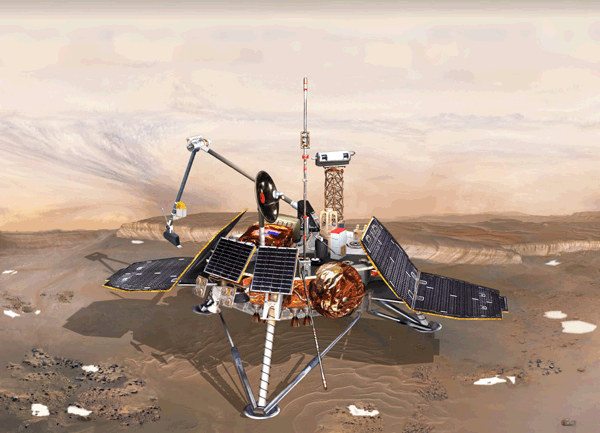Westerbork and Lovell Telescopes Complete the Search for the Lander
February 7, 2000

The Mars Polar Lander, NASA
DWINGELOO, The Netherlands, MANCHESTER, United Kingdom and PASADENA, California, USA --- The Westerbork Telescope (WSRT) in The Netherlands and the University of Manchester's Lovell Telescope in the United Kingdom are preparing for a second set of observations on Tuesday, February 8, to round off the search for the missing Mars Polar Lander. A second set of observations is required in order to eliminate remaining uncertainty on the operational status of the batteries of the Lander. The observations will consist again of two transmissions lasting half an hour each with a two-hour cooling-down period in between. NASA has already initiated the command procedure for this experiment using the Deep Space Network (DSN).
NASA mission managers theorize that the lander may be in a different configuration than expected. As a result, last Friday's command sequence sent by the NASA Deep Space Network may not have been received or executed by the Lander. This eventuality will be checked in the observational sequence of Tuesday.
The experiments of last Friday, February 4, have not been completely conclusive. Both telescopes have operated optimally throughout the experiments. The observational data from the Westerbork and Jodrell Bank Observatories have been analysed extensively but no coincidences have been found in the data suggesting transmissions from the Polar Lander. Only signals that occur in the data streams of both telescopes could be considered to originate from Mars. The two telescopes have a similar sensitivity for detecting signals from the Lander. Thus far all detected signals are thought to be of a terrestrial origin. Exhaustive analysis of the new data obtained in the Tuesday experiment will take at least until the end of the week, after which more definite conclusions about the state of the Lander will be made.
Both telescopes have used pulsar detection instruments during all observations. At Westerbork the PuMa instrument is a collaborative effort of ASTRON, and the Universities of Utrecht and Amsterdam. The high speed data acquisition system and processing cluster used in the Lovell Telescope observations was funded by the Particle Physics and Astronomy Research Council (PPARC) of the United Kingdom.
The Westerbork Synthesis Radio Telescope (WSRT) is operated by ASTRON, the Netherlands Foundation for Research in Astronomy, and is financed by NWO, the Netherlands Organisation for Scientific Research.
The 76m Lovell Telescope is located at the Jodrell Bank Observatory which is part of the of the Department of Physics and Astronomy of the University of Manchester.
Mars Polar Lander is managed by the Jet Propulsion Laboratory of NASA's Office of Space Science, Washington, D.C.. Lockheed Martin Astronautics Inc, Denver, Colorado, is the agency's industrial partner for development and operation of the spacecraft. JPL is a division of the California Institute of Technology, Pasadena, California.
MEDIA OFFICE
ASTRON - Netherlands Foundation for Research in Astronomy
Dwingeloo, The Netherlands
Telephone (+31) 521 595 223
http://www.astron.nl
University of Manchester,
Jodrell Bank Observatory.
Telephone: +44 (0)1477 571321
FAX: +44 (0)1477 571618
email im@jb.man.ac.uk
http://www.jb.man.ac.uk
MEDIA RELATIONS OFFICE
Jet Propulsion Laboratory
California Institute of Technology
National Aeronautics and Space Administration
Pasadena, California 91109. Telephone (+1) 818 354-5011
http://www.jpl.nasa.gov


